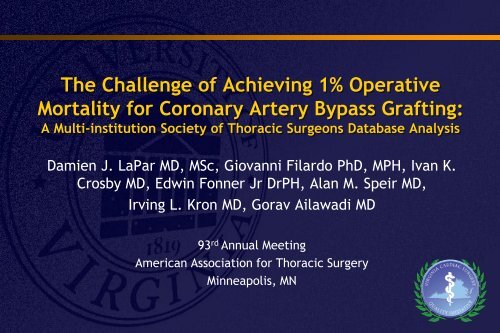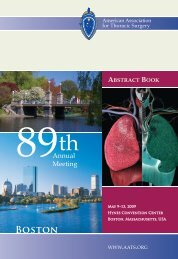P Median STS PROM - American Association for Thoracic Surgery
P Median STS PROM - American Association for Thoracic Surgery
P Median STS PROM - American Association for Thoracic Surgery
Create successful ePaper yourself
Turn your PDF publications into a flip-book with our unique Google optimized e-Paper software.
The Challenge of Achieving 1% Operative<br />
Mortality <strong>for</strong> Coronary Artery Bypass Grafting:<br />
A Multi-institution Society of <strong>Thoracic</strong> Surgeons Database Analysis<br />
Damien J. LaPar MD, MSc, Giovanni Filardo PhD, MPH, Ivan K.<br />
Crosby MD, Edwin Fonner Jr DrPH, Alan M. Speir MD,<br />
Irving L. Kron MD, Gorav Ailawadi MD<br />
93 rd Annual Meeting<br />
<strong>American</strong> <strong>Association</strong> <strong>for</strong> <strong>Thoracic</strong> <strong>Surgery</strong><br />
Minneapolis, MN
Disclosures<br />
None
Virginia Cardiac <strong>Surgery</strong><br />
Quality Initiative<br />
Voluntary consortium of 17 collaborating cardiac surgical<br />
centers with Virginia.<br />
Capture approximately 99% of Virginia’s cardiac operations<br />
Each center contributes data to <strong>STS</strong> Adult Cardiac <strong>Surgery</strong><br />
Database<br />
Quarterly Meetings<br />
<br />
<br />
<br />
Quality initiative development and planning<br />
Outcomes Analysis and Review<br />
Establish cooperative guidelines <strong>for</strong> clinical and systems-based<br />
intervention
Trends and Challenges in CABG Mortality<br />
Per<strong>for</strong>mance of CABG has declined as first-line treatment <strong>for</strong><br />
coronary artery disease with advances in PCI technology.<br />
Current estimates of mortality following PCI are approximately<br />
1%, while those <strong>for</strong> isolated CABG are approximately 2%.<br />
Surgical community recently challenged by cardiothoracic<br />
surgical leadership to achieve a ≤1% CABG mortality rate in next<br />
3-5 years.<br />
Feasibility of this goal remains unknown.
Purpose<br />
1. To determine whether the challenge to achieve a ≤1% operative<br />
mortality rate <strong>for</strong> primary, isolated CABG operations is feasible in<br />
the modern surgical era<br />
2. To identify in which patient populations this mortality goal is<br />
achievable relative to <strong>STS</strong> Predicted Risk of Mortality (<strong>STS</strong> <strong>PROM</strong>)<br />
3. To identify factors that contribute most to mortality among<br />
patients where goal mortality was deemed not achievable in<br />
order to determine whether certain patients should not receive<br />
surgical myocardial revascularization
VCSQI<br />
(2001-2011)<br />
Primary, Isolated CABG<br />
(n=34,416)<br />
Identify Threshold <strong>for</strong> <strong>STS</strong> <strong>PROM</strong> with<br />
1% CABG mortality<br />
<strong>STS</strong> <strong>PROM</strong> ≤ Threshold<br />
(n=19,720)<br />
<strong>STS</strong> <strong>PROM</strong> > Threshold<br />
(n=14,687)<br />
Survivors<br />
(n=14,138)<br />
Decedents<br />
(n=549)
Methods<br />
Primary Outcome:<br />
Risk adjusted association:<br />
• <strong>STS</strong> <strong>PROM</strong> score and operative mortality<br />
Secondary Outcomes:<br />
Mortality risk adjusted associations:<br />
• 30 predictor variables used to calculate <strong>STS</strong> <strong>PROM</strong><br />
• Process of Care Measures<br />
• IMA Use<br />
• Perioperative/Discharge Medication Use<br />
• Beta-blocker<br />
• Anti-platelet<br />
• Lipid lowering
Univariate Analyses:<br />
<br />
<br />
Statistical Analyses<br />
Categorical data: Pearson’s Chi-square or Fisher’s Exact<br />
Continuous data: ANOVA or Wilcoxon Rank Sum<br />
Hierarchical mixed effects regression:<br />
<br />
<br />
Hospitals as random effect<br />
Operative Mortality<br />
• Adjustment:<br />
• <strong>STS</strong> <strong>PROM</strong> (restricted cubic spline)<br />
• Surgeon Volume (restricted cubic spline)<br />
• Operative Year
Results
<strong>STS</strong> <strong>PROM</strong> Highly Associated with CABG Mortality<br />
Factor<br />
Effect Size<br />
(Likelihood Ratio)<br />
Adjusted<br />
Odds Ratio<br />
[95% C.I.]<br />
P<br />
<strong>STS</strong> <strong>PROM</strong> (linear) 846.7 1.89 [1.68, 2.09]
Adjusted Relationship CABG Mortality ~ <strong>STS</strong> <strong>PROM</strong>
<strong>STS</strong> <strong>PROM</strong> Threshold (1.27%) = 1% CABG Mortality<br />
1%<br />
1.27%
Modeled Factor Effect Sizes:<br />
<strong>STS</strong> <strong>PROM</strong> ≤ Threshold (1.27%)
Modeled Factor Effect Sizes:<br />
<strong>STS</strong> <strong>PROM</strong> > Threshold (1.27%)
CABG Patients At Risk For Death (<strong>STS</strong> <strong>PROM</strong> > 1.27%)<br />
Survivors Decedents<br />
Variable<br />
P<br />
(n=14,138)<br />
(n=549)<br />
<strong>Median</strong> <strong>STS</strong> <strong>PROM</strong> (%) 2.4 [1.7,3.9] 4.6 [2.7,9.2]
Limitations<br />
Retrospective design<br />
<strong>STS</strong> definitions<br />
De-identified data points<br />
Lack of long-term follow-up
Conclusions<br />
1. Goal to achieve ≤1% operative mortality <strong>for</strong> primary, isolated<br />
coronary artery bypass grafting may be feasible but only in<br />
highly selected patients in the modern surgical era.<br />
2. <strong>STS</strong> Predicted Risk of Mortality score can be used to strongly<br />
identify patients with a threshold value of estimated mortality<br />
risk ≤1.27% to achieve this goal.<br />
3. Goal may only be achievable in less than 60% of CABG patients<br />
without other improvements in processes of care.

















